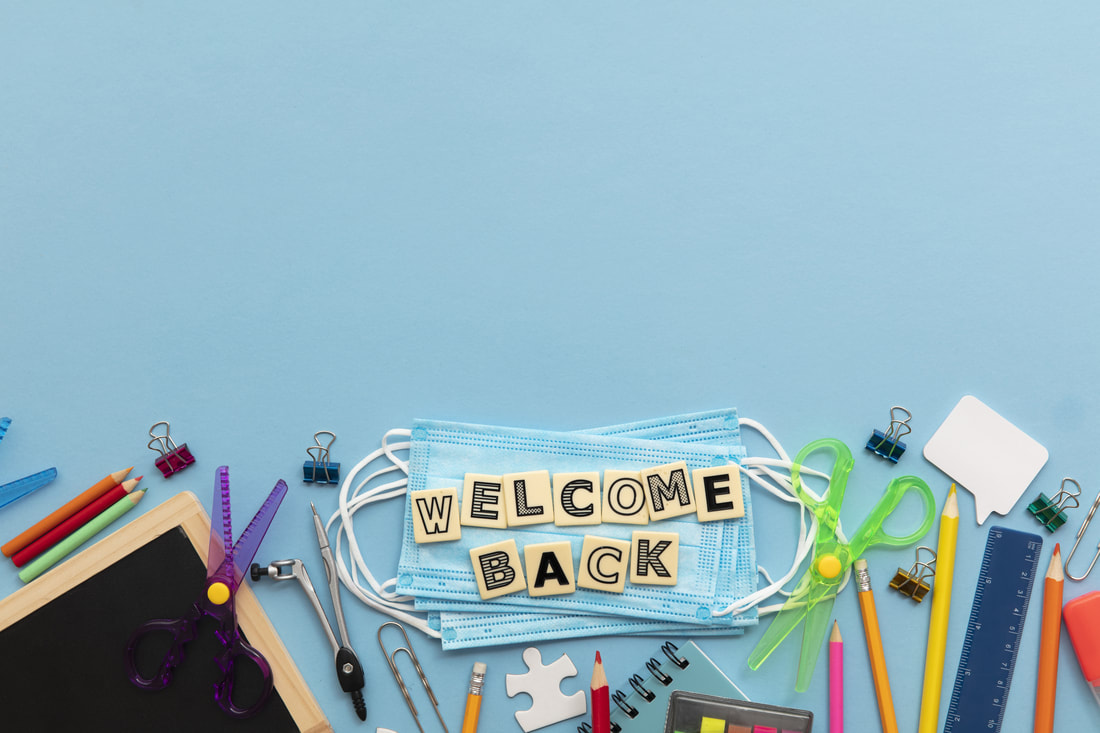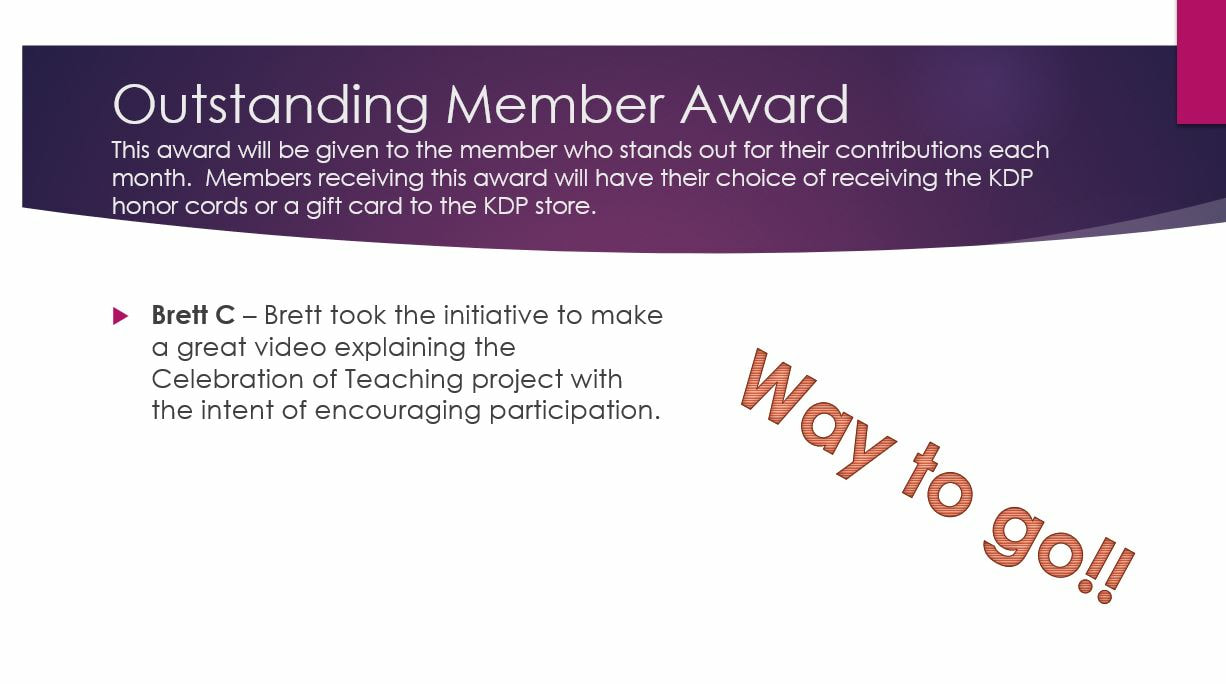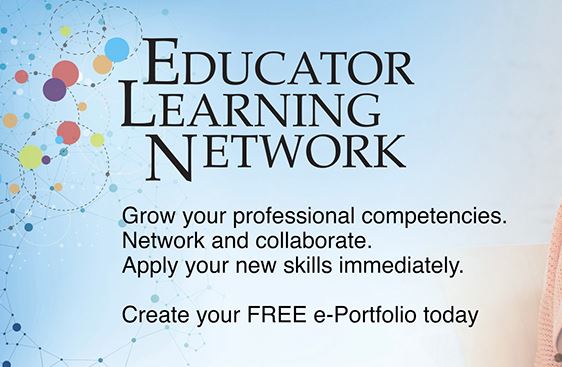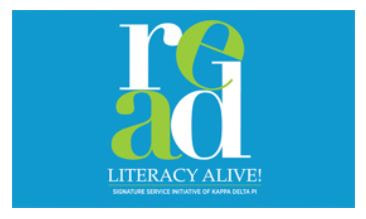|
by Shannon Edwards and Rachael Grillo
Quizizz *What is it? Quizizz is an online quiz platform for both practice and assessment.
Classroom Screen *What is it?
Adobe Spark *What is it?
1 Comment
by Chelsey Trinklein, Chapter Historian
Recap of 2019-2020 In case you missed it, earlier this year our KDP Alpha Epsilon Sigma (AES) chapter celebrated its 10th birthday! That’s right! The WGU chapter of KDP was installed on February 19, 2010 by Dr. Heather Dodds. We started with only 179 members and now have over 4100 members. On March 10, 2020, our previous board hosted an awesome virtual party in celebration of such a monumental event. This last year, AES also participated in KDP’s signature service initiative Celebration of Teaching, led by Vice President Jessica Martz. This project recently received the Silver Award. Congratulations to Jess and her Celebration of Teaching committee! Coming up this year Things are looking different for each of us as we begin our Back to School 2020. Some of us are back in the classroom and navigating best practices while social distancing. Others of us are completely online trying to make connections with students through a camera. Then some of us are trying to balance a hybrid. Teaching simply isn’t what we knew it to be or expected it to be. This year at KDP, we want to be here for you. To do that, we’re kicking off our first member meeting with professional development covering online teaching best practices. For those of you who have already started fully remote or hybrid teaching, what is working for you? What lessons have you learned? Meeting Schedule The 2020-21 meetings are scheduled for the following dates, so mark your calendars:
New to KDP? I encourage you to browse Kappa Delta Pi resources here. There are both classroom resources and professional development resources. My favorite resources page is the KDP Resources Catalog. Here you can browse resources by category or search for what is relevant to you. I like looking at the webinars, but the articles are excellent as well. Outside resources for current WGU students As educators, we all have those go-to websites for classroom resources and professional development. I’d like to share a couple of mine. LinkedIn Learning. There are a ton of courses. For example, they have courses on mindfulness, time management, and more specific topics related to business and education. Just use the search bar. I searched “lesson planning” and there are 170 results for videos and full “courses”. If you need help accessing this resource, let me know and we can try and troubleshoot. Office 365. This gives you access to OneDrive and various apps specific to Microsoft. For active WGU students, simply log in with your student.wgu.edu account and you should be good to go. Edweb.net. This website has a lot of educational webinars, which have state department of education approval for teacher re-licensure in New York, Massachusetts, Texas, Pennsylvania, Arkansas, Kentucky, Utah, and Nevada. As always, double check to make sure. What are your favorite student and teacher resources? Share in the comments! by Linda Burns, chapter member
It’s January. It’s football season, and Super Bowl XLIV is right around the corner. Super Bowl is exciting! We recover from the holidays and all the hustle and bustle to throw football parties and cook comfort foods which make the house smell delicious. Simmering pots of chili, spice rubbed ribs and smoky hot wings are on the menu, as well as vegetable platters, chips with award winning dip and our favorite salsa from the best Mexican restaurant in town. We invite our closest friends; the friends we feel so comfortable with that we can wear sweatpants or grungy jeans, yell at the television while shoveling chips into our mouths and know they still love us. While many of us and our families “actively” watch the games, we are watching from our couches. We are merely spectators. We see what happens on the field, but what happens in the locker room? What happens at half-time while we are watching elaborate musical performances? I think I have a pretty good idea. No matter how the game is going, at half time, the team has a chance to reflect on the first half and see what can be done to improve the second half. They know the team they are playing. They know their moves; their strengths and weaknesses and they know what they have to do. They are in a different position than they were at the very beginning of the game, because they have had the chance to work with this team up close and personal. We are teachers, and teaching is not a spectator sport. Do you remember last August? You may have ridden in from summer break full of adrenaline and excitement, prepared with new tools and goals for the school year. It’s 2020, a brand-new year! It’s the second half! Aren’t we lucky? As teachers, we get to revamp, re-start, re-organize and reconnect with our students as we enter the second semester. Bring the high energy of the roaring 20's into 2020 and set the tone for the next decade. Let’s move into this new semester with renewed energy and excitement! Use what we learned first semester to help our students achieve their learning goals and become the MVP’s they are meant to be. by Rachel Tyler, Chapter President January 1st may be the beginning of the new year for most, but a new school year is a new start for over 49 million students, 4 million teachers, and countless school administrators and employees here in the United States. Joining these millions of students and school employees are about 200,000 student teacher candidates. Maybe you are one of these 200,000? This year I am lucky to be one of the 200,000 beginning their student teaching. If you are anything like me, you are a nervous wreck, excited, and stressed. Good news is this the very last thing standing in between you and your licensure. Bad news, actually I can’t think of any bad news. We just have to get through this together. I have compiled together advice from those who have already student taught and decided to share it with you. 1. Prepare for the unexpected. During student teaching, you will spend a lot of time planning lessons and going over them with your host teacher. Even with a well thought out and thorough lesson plan, it is possible for something to go not as expected. The students could be a little rowdier that day. Maybe they are not catching on as quickly, or they finished faster than expected. It is also sometimes almost impossible to plan around drills, emergencies, and technology failing. Just as important as it is to plan for a lesson it is important to plan to be flexible, or as someone used to tell me “go with the flow." Remember to always try to have alternative activities and to try to keep your lessons has engaging as possible. 2. Ask questions. For some this may be a no brainer, for others it may be the hardest thing you have to do. If you are anything like me asking questions, especially when you first meet someone, is nerve wrecking. Student teaching is the perfect time to get those burning questions answered. Ask your host teachers about what they learned that works and doesn’t work when it comes to managing their classrooms. Use their experience in lesson planning, grading, and organization to help you in your future classroom. Do not be afraid to ask questions that you may find silly. There is no such thing as a stupid question. If you are unable to find time to ask your questions, write them down and ask your host teacher later. 3. Leave your comfort zone. Trust and believe me, I understand how scary student teaching can be. I have spent the last three years in the classroom as a teacher’s aide and I am still petrified to begin my first day of student teaching. Do not be afraid to fail and do not be afraid to share some of your own ideas with your host teacher. What better time than now to fail and try again? It is also the perfect time to put all of the things you learned in the classroom to the test. 4. Stay organized. It will be imperative for student teachers to try to be as organized as possible. Student teaching is like working and going to school full time. After spending 6-8 hours in the classroom you will need to make sure you are setting time aside for preparing for the next time when you get home, your own class assignments given you by your professors, and all of your daily adulting responsibilities. Your plate can fill up quickly if you do not stay on top of it. Try to make a schedule and stick to your it, and express to others when you need a little bit of help. Trust me you are going to need help. 5. Remember to take care of yourself. It is going to be easy to get swallowed up by all of your responsibilities. It is always most important to take care of your mind, body, and soul so that you can stay on top of your game during student teaching. The best student teacher is a happy and healthy student teacher! Engage in a regular sleeping routine and healthy eating practices to maintain the much-needed energy. It is also important to try to exercise throughout the week. When things are becoming too stressful take a small break. Reward yourself! You deserve it, you made it this far and you are going to make it through student teaching. Congrats to all of those who will be student teaching during the 2019-2020 school year. Happy New Year to you all! To all other teacher candidates who aren’t quite there yet…Don’t worry your time is coming soon. Congratulations to all of our award winners! The Executive Board is so appreciate of your efforts and your support of AES! It wouldn't be the same without the excitement and participation of our members. Thank you!
Rachael GrilloAES Chapter Secretary Free Certification/Badges for Teachers
Are you a teacher looking for some ways to enhance your students’ learning experiences? Maybe you are looking for things that will enhance your resume and assist you in job hunting? Or you just like freebies….. Whichever category you’re in, here’s some training that can better you in the classroom. AND THEY ARE FREE! Nearpod Certified Educators As a teacher, I relied on PowerPoint notes and then sometimes did exit tickets or short quizzes to check for understanding. Everybody had to be on the same page. What I love about Nearpod is that you can build the interaction right into the slides. You can do live presentations or do student-paced and allow the students to go through it at their own pace. You can integrate videos, quizzes, open-ended question, matching games, etc right into the slideshow. Nearpod will track not only participation (if they interact with the interactive slides), but also accuracy on things like the matching and quizzes. It’s easy for teachers to pull a report (and save paper). First, Nearpod recommends you attend a webinar to learn more about what will be expected of you to achieve certification. Next, Nearpod gives you an outline of what your submitted lesson must contain. Finally, you must launch your lesson and have at least 15 students use it. It’s just that easy! I submitted my application and heard back within two weeks that I was now a Nearpod Certified Educator! They also sent me a certificate. There is NO COST. If you’re interested, the website with all information is found here: https://nearpod.com/certified-educator Common Sense Educators Common Sense Media has a certification called “Common Sense Educators”. There is also no cost for this program. Common Sense Media is all about assisting students in the digital age and providing teachers with the skills and tools to achieve that. The Common Sense Educator badge “publicly affirms your commitment to helping students think critically and use technology responsibly to learn, create, and participate” (Common Sense Media website). Common Sense Media provides three sections to complete to attain the certification. First is “Learn” where you do a series of activities to “level up your teaching practice”. Second is “Do”, where you choose two activities in which you will engage your students. Last is “Reflect”, where you will reflect upon the process. Again, there is no cost. If you’re interested, the website with all information is found here: https://www.commonsense.org/education/recognition-educators Microsoft Innovative Educator The Microsoft Innovative Educator badge is free. The goal is to learn fundamentals to apply technology in education. The website is very personalized because you only have to complete tasks adding up to 1000 points to get the badge and there’s a lot to choose from. I chose one task that was 1500 points to complete the badge, but you can complete several smaller tasks or a larger one. The choice is yours. If you’re interested, the website with all information is found here: https://education.microsoft.com/microsoft-innovative-educator-programs/mie If there are other free badges or certifications you know of, please share in the comments below! Rachael GrilloAES Chapter Secretary If you have anything to do with a classroom or education, you have probably heard the term “differentiation” over and over and over again. We have a good idea of what it is, but with the diversity of learners in our classrooms, the challenges to implementing differentiation seems insurmountable. Every resource has a different idea of how best to utilize differentiation in a classroom. One method that I use in my high school science class (covering special education through advanced placement) are choiceboards.
In this blog post, I am going to cover some types that I have found work well in my classrooms that can be easily adapted for use in any classroom. These are simply things I use to help me differentiate, but they’re not the only way. They’re a great way to incorporate graphic organizers while allowing student choice and teacher structure. Tic-Tac-Toe We’re all familiar with the game Tic-Tac-Toe. How on Earth does it apply to differentiation? It’s easy! You create 9 assignments in a tic-tac-toe board and students choose 3 to complete. However, they must complete 3 in a row for tic-tac-toe so you can make sure that a variety of assignments are completed. There are so many different activities you can use. Some ideas for student choice activities can be:
Now, some of these activities seem very basic. This is where the teacher in you comes into play! You don’t want the student to simply to regurgitate information – you want them to demonstrate some level of understanding. I try to arrange them in such a way that each tic-tac-toe has a variety of mastery levels and a variety of different activities. Here is a model that I ask my chemistry students to create:
As you can see, they are creating a model but in order to create that model, they have to be able to create and explain different chemical reactions. An art teacher could use this method to show mixing colors to create new colors. A math teacher could use it to show addition. Here are 2 options I ask my physics/physical science students to choose from:
They have to be familiar enough with the laws to apply them to their own life and explain the relationship to the sport. Need students to learn vocabulary?
The assignment choices do not have to require lots of photocopies or a ton of instructions. I’ve had students create memes to explain concepts and vocabulary words and act out scientific principles. Sometimes I leave the middle as a “free space” where students can bounce an idea off of me to try to use for mastery. You can re-use the same option multiple times in the tic-tac-toe board if it’s one thing you really need to force the students to complete. You can have all 9 boxes be different. It’s also easy to have the board on one side and a rubric on the other side so that everything fits and students know what will be expected. Here is a sample chemistry choice board: https://docs.google.com/document/d/1boR_IKh_jdLpMfWOiYcVWJHpbDKwo6DRCkOOmJvpK8U/edit?usp=sharing Menu Boards Another method of differentiation is using menu boards. It’s not as popular of an option as the tic-tac-toe, but is still useful. I use menu boards frequently in my high school science class but again, this can be adapted for any level or course. My version of the menu boards is a restaurant menu. There can be appetizers, side dishes, entrees, and desserts. It’s also a lot of fun (for me, at least) when I have the time to format them to look like an actual menu. I will often list the “easier” or low DOK (depth of knowledge) assignments under the appetizer option and ask them to choose one to complete. The more involved or “meatier” options are listed under the entrée section and they are to choose one (and the entrée is worth the most points). There can be side dishes listed if you choose (when I use side dishes, I have them choose two to complete). Finally, there is a list of desserts to choose from (or just one dessert that everybody does). Here is a sample I use for my environmental science class: https://docs.google.com/document/d/1Tn_xlLum0uqkvoqnAYp9Hg9VAE_M3nInRBsd2obBS1E/edit?usp=sharing So those are two ways to incorporate student voice and choice and differentiation into your classroom. There are SO many other ways, so don’t limit yourself to just these. Good luck and be sure to enter the giveaway below! You must be a current KDP AES chapter member to enter and you will be asked to provide an email address where you can be reached to claim your prize. Prizes not claimed in 3 days will go to the next person on the list. Please click here to enter the drawing: http://www.rafflecopter.com/rafl/display/0bebab240/? by Rachel Tyler, Chapter President
Being a member of Kappa Delta Pi is an amazing accomplishment and it is even better that you are a part of the Alpha Epsilon Sigma chapter here at Western Governors University. As fully-fledged members of KDP, we have access to many member benefits as undergraduate and graduate students, as well as on the professional level. Kappa Delta Pi provides us with career and leadership development resources. Recently KDP partnered with Educator Learning Network. ELN provides us with learning opportunities that will help grow your professional competencies. The courses are discounted for members and sometimes even free! The current courses include Classroom Management Basics, Data Literacy for Teaching, and Educator Wellness. New courses are added often. To access your courses log in to your Kappa Delta Pi profile, look under my Engagement and click “Enroll in Educator Learning Network Courses.” You also have access to a free e-portfolio to track and share your professional development with employers. Your e-portfolio can be found under My Account and click “My ePortfolio”. As a member you have the opportunity to attend webinars, podcasts, and plenty of face-to-face professional development held across the country. Don’t forget to attend Convocation. It is held yearly. You may also submit a proposal to present at one of the workshops or Convo. As an undergraduate student you will have a free subscription to New Teacher Advocate, and Kappa Delta Pi Record as a graduate student. Members receive monthly e-newsletter, access to archived KDP publications you can use for your research, and downloadable teacher resources. Kappa Delta Pi offers classroom teacher grants and scholarships. Classroom grants are $150 and scholarships range from $250 to $3,500. As members you will have lifetime access to great member discounts including professional liability insurance, life and auto insurance, health and disability insurance, and international travel/medical coverage. Kappa Delta Pi wants to recognize all the hard work their members put into their education and professional careers. As a student don’t forget to wear your KDP stole and honor cords at commencement. KDP also honors teachers with the Teacher of Honor recognition. Being a part of KDP is a great achievement and has awesome benefits. Don’t forget to be an active member of our Alpha Epsilon Sigma family. Attend bi-monthly professional development meetings, and be a part of our committees, including the new service initiation Celebration of Teaching. Don’t forget to stay an active member by paying your dues so you can continue to receive all the benefits of Kappa Delta Pi. We are so excited to have all of you a part of Kappa Delta Pi – Alpha Epsilon Sigma Chapter. To see all benefits, click here http://www.kdp.org/membership/pdf/MemberBenefits.pdf We are excited to announce that our chapter's project, Digital Literacy, was named a Gold Winner for 2017-2018! This is the highest award given to Literacy Alive! projects. If you haven't taken the time to view the project, there are two versions linked below.
Website: https://sites.google.com/site/digitalliteracyliteracyalive/ iBook: http://itunes.apple.com/us/book/id1385252117 As a Gold winner, our chapter will receive a plaque at Convo 2018 in Indianapolis, IN, and every chapter member is eligible for a $20 Convo registration discount. If you are attending Convo, use the code LA20 when registering. Special thanks to our LiteracyAlive! Committee, including our committee chair, Jess Martz! by Kacie Ryan, Faculty Co-counselor
Literacy Alive! is a service project that Kappa Delta Pi chapters across the world participate in each year. The focus of the initiative is to empower literacy skills within participants. Participating chapters create their own programming that focuses on literacy skills related to cross curriculum programming, community partnerships, international impact, needs of diverse populations, and sustainable development. In these topics, the programming design is left open ended for participating chapters. Projects typically range from one day literacy events to on-going literacy programs. For more information visit the KDP’s Literacy Alive! page. Our AES chapter has participated in Literacy Alive! for several years. Each year we create a Literacy Alive! committee who designs and implements our project. Our focus over the last few years has been on compiling teacher resources. We’ve also chosen to leverage our position as the first online chapter of KDP by providing our resources through different online platforms. Last year we created a Live Binder classroom resource. Our committee decided to focus on diverse populations and narrow that to students with behavioral disabilities. Committee members identified books about people with behavioral disabilities and created elementary level lesson plans and read aloud companions to accompany the books. The committee also complied some online resources that could help teachers working with and teaching students with behavioral disabilities. We assembled all of these resources into an online Live Binder to allow access to our project by any teacher, anywhere. You can check out last year’s project here. As an officer board, we decided that our chapter’s project for this year will focus on digital literacy in K-12 education. The American Library Association defines digital literacy as “the ability to use information and communication technologies to find, evaluate, create, and communicate information, requiring both cognitive and technical skills." Our committee will work with this topic to create our 2017/2018 Literacy Alive! project. The committee is forming now! If you’re interested in joining the committee, or have questions, please let us know by emailing [email protected]. |
AuthorAES Chapter Archives
March 2021
Categories |
Proudly powered by Weebly









 RSS Feed
RSS Feed